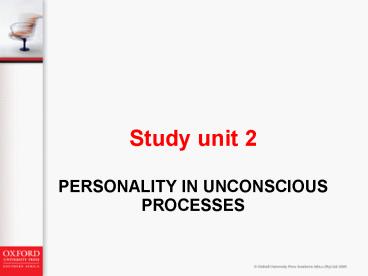Personality in unconscious processes - PowerPoint PPT Presentation
1 / 20
Title:
Personality in unconscious processes
Description:
Study unit 2 PERSONALITY IN UNCONSCIOUS PROCESSES * * * * * * * * * * * * * * What are the main contributions of psychoanalysis and why is it important? – PowerPoint PPT presentation
Number of Views:91
Avg rating:3.0/5.0
Title: Personality in unconscious processes
1
Personality in unconscious processes
- Study unit 2
2
- What are the main contributions of psychoanalysis
and why is it important? - Describe background of the psychodynamic
perspective - Name and discuss the basic assumptions of the
psychodynamic perspective - Describe the structure, development, motivation
and adjustment of personality according to the
psychodynamic perspectives - Describe the main contributions and criticism of
psychoanalysis.
3
Psychodynamic assumptions
- Personality seen as dynamic set of processes
- Processes sometimes work in harmony, sometimes
against each other but are never passive - Competing pressures within personality conflict
with each other - Conflicts which take place among the elements of
personality are often unconscious - The basic drive is sexual (life instinct),
supplemented by aggression (death instinct), and
has its foundations in the biology of the
individual - Individuals history is important in determining
contemporary behaviour - Mental health depends on balance of forces in
ones life - The defence mechanisms of the ego protect an
individual from psychological harm.
4
Ego-defence mechanisms
Repression Unconscious preventing or denying threatening or painful experience
Projection Ascribing of own threatening and undesirable thoughts, etc to others
Reaction formation Behaving in a manner which is opposite to ones true feelings
Displacement Directing negative emotions from original source to substitute object
Fantasy Fulfilling frustrated needs through imaginary success or wishful thinking
Overcompensation Protecting ones weaknesses by over emphasising certain aspects
Intellectualisation Isolating hostile experiences by ascribing intellectual meaning to them
Rationalisation Finding logical but false excuses to justify irrational behaviour
Regression Avoiding painful feelings by reverting back to less threatening behaviour
Identification Defending against threatening feelings by relating to an idea
Sublimation Channelling threatening behaviour into acceptable outlets - displacement .
5
Mechanism of repression
Threshold of consciousness
6
Typographical model
- The conscious
- Sensations and experiences people are aware of
- The preconscious
- Memory not readily available to awareness
- Can easily be retrieved into awareness
- The unconscious
- Experiences not easily accessible/repressed to
awareness.
7
Structure of personality
- The id
- Pleasure principle
- Seeks immediate gratification
- Contains instincts life (libido) and death
drives - The ego
- Reality principle
- Evaluative agent selects behaviour with less
pain - The superego
- Morality principle
- Suppresses pleasurable demands of the id
- Two subsystems
- Conscience which punishes
- Ego ideal which rewards.
8
The Johari window
9
Levels and structures of personality
Levels of consciousness Structures of personality
Unconscious Conscious Pre-Conscious Conscious Pre-Conscious Unconscious Id Ego Ego and Superego
10
Levels and structures of consciousness
11
Freuds psychosexual development
- Fixation
- Being stranded in the tasks of a previous
psychosexual stage - Oedipus complex
- A male childs unconscious desire to possess the
opposite-sex parent and simultaneously dispose of
the same-sex parent - Electra complex
- A female childs unconscious desire to possess
the opposite-sex parent and simultaneously
dispose of the same-sex parent - Womb envy
- Both sexes envious of each other.
12
Jungs five archetypes
- Persona
- Mask presented by person to the world
- Anima
- Feminine part of men
- Animus
- Masculine part of women
- Shadow
- Similar to Freuds id
- Consists of biological instincts
- Source of immoral and passionate impulses
- Self
- Most important archetype, holds all others
together - Represents striving for a whole and integrated
personality.
13
Jungs level of consciousness
- Ego/conscious
- Personal unconscious and its complexes
- Collective unconscious and its archetypes
- 2 attitudes
- Introversion/extroversion lead to functional type
- 4 functions
- Sensing (S)
- iNtuition (N)
- Thinking (T)
- Feeling (F).
14
Motivation
- Jung
- Archetypical influences
- Psychic energy
- Directed at other achievements, not only
homeostasis (future directed) - Self-actualisation
- Causal-teleological principle
- Adler
- Creative self
- Fromm
- Organic and non-organic drives
- Organic animal-like instincts
- Non-organic distinguish human from animals.
15
Characteristics associated with the 16 MBTI
personality type
Sensing Sensing iNtuitive iNtuitive
Introvert ISTJ ISFJ INFJ INTJ Judging
Introvert ISTP ISFP INFP INTP Perceiving
Extrovert ESTP ESFP ENFP ENTP Perceiving
Extrovert ESTJ ESFJ ENFJ ENTJ Judging
Thinking Feeling Feeling Thinking
16
Mahlers four stages in process of separation and
individuation
17
Personality adjustmentThe healthy personality
- Freud
- Well adjusted person
- Adler
- Inferiority and superiority complex and sibling
rivalry - Fromm
- Productive frame of orientation
- Jung
- Emergence of self through individuation.
18
Personality adjustmentPsychopathology
- Freuds 3 forms of anxiety
- Reality anxiety
- Experienced in face of real danger
- Neurotic anxiety
- Experienced when id impulses are in conflict with
the ego - Moral anxiety
- Represent conflict between ego and superego.
19
Personality adjustment
- Freuds concept of transference
- Positive transference affectionate feelings
towards therapist - Negative transference expression of hostile
feeling towards therapist - Erickson
- Sense of identity
- Rank
- Birth trauma/separation anxiety
- Horney
- Neurosis/basic anxiety
- Fromm
- Non-productive person
- Receptive orientation
- Exploitative orientation
- Hoarding orientation
- Marketing orientation.
20
Thank you.































